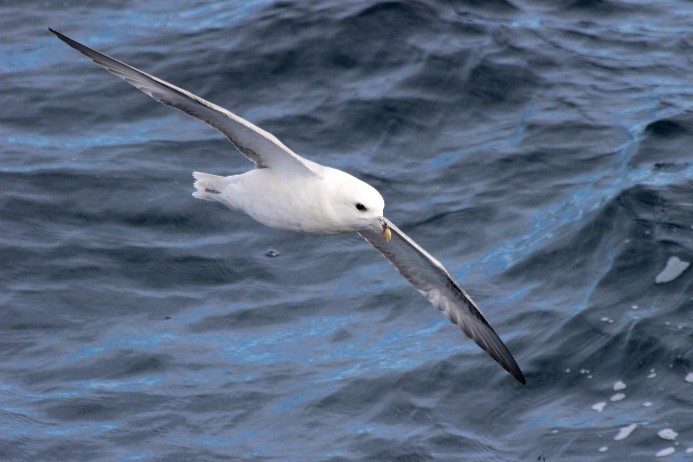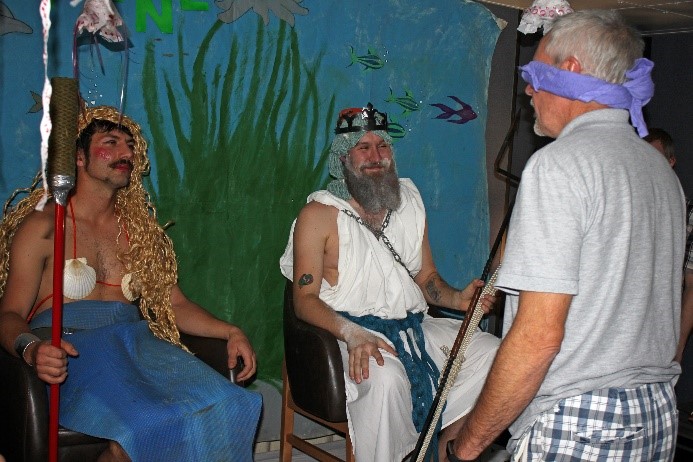Arctic Adventure on the Amundsen
Sabena Blackbird from the University’s School of Environmental Sciences is working on WP2 “Functional Ecosystems” for the EU Horizon 2020-funded ATLAS project alongside Professor George Wolff and Principal Investigator Dr Dick van Oevelen (NIOZ). The ATLAS project is striving to improve our understanding of complex deep-sea ecosystems and their associated species.
During the summer Sabena joined expedition Leg 2c from Iqaluit to Resolute Bay in the Eastern Arctic on board the Canadian Coast Guard Ship Amundsen alongside ATLAS project partner Graham Tulloch (BGS) and over 40 ArcticNet scientists. The outreach article below was written as a follow-up to Graham’s account on his ATLAS activities on the CCGS Amundsen.
Arctic Adventure on the Amundsen
While Graham Tulloch was on deck tackling the challenges associated with programming and attaching the equipment for the landers I was preparing for my ATLAS role in the expedition. The two sites at which the landers were to be deployed were specifically chosen to be in contrasting locations in Southern Baffin Bay – a ‘non-sponge site’ at SE Saglek bank within the Hatton Basin fisheries closure area which had the lowest sponge bycatch value from trawl surveys and a ‘sponge site’ at NE Saglek bank with abundant sponges including Geodia, Asconema and Polymastia sp. along with soft corals including the stunning red tree coral Primnoa resedaeformis.
Our key objective is to gain in-depth understanding of the food sources and food delivery pathways to the sponge grounds and coral reefs. The landers will give us some valuable long-term data on near-bottom currents and downward particulate flux but my concerns were very much in the ‘here and now’. I was to be sampling the organic matter and food distribution in the water column using a number of biogeochemical parameters on two CTD shelf/slope transects, each with five stations, across the lander sites.
My lab was in a converted shipping container on the port aft side of the helideck. After locating the aluminium boxes containing lab equipment and consumables that had been sent from the University of Liverpool and NIOZ along with fixative chemicals that David Coté of Fisheries and Oceans Canada had kindly organised, I began setting up the vacuum filtration manifolds and labelling innumerable vials of various sizes in anticipation of the challenge ahead.
Before joining the expedition I’d been in contact with the chief CTD rosette operator Pascal Guillot of Amundsen Science so he was briefed on the sampling depths Atlas required - surface, chlorophyll max, mid-water - evaluated on CTD downcast at the lower end of the deep thermocline, 50mab and 10mab.
I donned my de rigueur Atlas beanie hat and sat in the CTD operator room with Pascal and assistant Solenne Caous, watching through the window into the adjacent rosette room as the Amundsen crew deployed the CTD rosette for its’ decent down the water column at the first ATLAS sampling station ‘Sponge Site 5’. With a bottom depth of only 299m the CTD rosette was soon on its return ascent, Pascal firing off the Niskin bottles to collect the seawater at the required depths. The crew expertly manoeuvred and secured the CTD rosette onto its base and Pascal extensively rinsed the carousel crown with fresh water to minimize biofouling between casts. After checking the CTD log sheet I pulled on my admirably gothic purple nitrile gloves, attached tubing to the Niskin bottle outlets, undid the pressure valves and began filling two 9 litre carbuoys for each of the five sampling depths. A number of volunteers kindly assisted me in carrying the carbuoys around to the lab – special thanks to Alec Aitken, Robert Izett and Anirban Chakraborty.
Then began the filtering frenzy! Vacuum filtration onto filter paper for POM (particulate organic matter) and Pigments; filtering seawater through in–line filters into vials for DOM (dissolved organic matter) and Inorganic Nutrients (Nitrate + Nitrite, Nitrite, Silicate, Phosphate and Ammonium). I was also collecting seawater for two different types of Flow Cytometry samples – Phytoplankton; Bacteria & Viruses - each requiring different fixatives and the samples to be cooled before flash freezing in liquid nitrogen.
I had barely finished the lab work and placed filters and seawater vials in various freezers when the next station was upon me. The pattern was repeated for the next few days and nights until I managed to grab a break between stations as the other scientific teams aboard addressed their research needs.

Northern Fulmar
It also gave me an opportunity to peak out of the lab door to observe the Northern Fulmars Fulmarus glacialis who were dedicated followers of the Amundsen throughout the voyage gliding over the surface of the sea on their stiff wings. There were even a couple of avian hitchhikers that landed on the helideck – a White-rumped sandpiper Calidris fuscicollis possibly on migration (they breed in arctic Canada and winter in southern South America) and a Pine Siskin Spinus pinus that happily twittered away. We were also lucky enough to see an albeit distant Polar Bear Ursus maritimus that flumped from an ice floe into the sea, strongly swimming into the distance and a few Cetaceans with Long-finned Pilot Whales Globicephala melas and Fin Whales Balaenoptera borealis.
After completing the remaining Atlas stations we steamed across to SW Greenland to a Lophelia pertusa site discovered accidentally in 2012 when a piece of this scleractinian coral was caught on a CTD rosette frame during water sampling activities. ROV operators from the Canadian Scientific Submersible Facility faced challenging conditions with high sea swell and strong currents as they investigated the steep bedrock where the Lophelia pertusa colonies were located between 750 and 950m. The video images relayed back to TVs in each cabin also showed a great diversity of soft coral, sponge and fish fauna.
Although ATLAS weren’t scheduled to sample the water column here it was too good an opportunity to miss. In George Wolff’s Organic Geochemistry lab at the University of Liverpool we routinely assess the organic chemical composition (quality) of suspended particulate organic matter (sPOM) by quantitative determination of lipid biological markers. Unfortunately the SAPs (stand-alone pumping system) that we usually use to collect sPOM from large volume water samples was unavailable for this cruise. I needed to adapt – instead filtering seawater onto four 47mm GF filters on the vacuum filtration manifold at each of the five sampling depths. This will add to our already large compositional data set of sPOM collected across a variety of locations with and without abundant Lophelia pertusa in the NE Atlantic continental margin.

Graham awaiting his fate in Neptune’s realm
‘All work and no play’ the proverb goes – well there was certainly going to be some fun as many of the scientists were going to be crossing the Arctic Circle for the first time. Those initiates, myself included, needed to endure a number of challenges over the course of three days and be thoroughly vetted by King Neptune (and his missus) before being allowed into the Order of the Blue Nose!